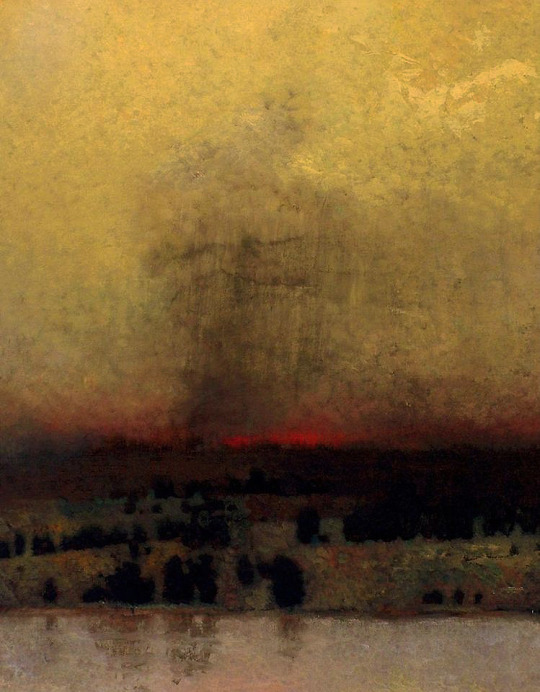#nesselrode
Text
The session of plenipotentiaries that never happened,
Or The tale of how I rediscovered that one lithography of Isabey’s famous painting in extremely high resolution and went through a total recall, so that everybody could suffer (myself including) ⭐️
The arrival of the Duke of Wellington had not only affected Vienna's diplomatic activity and social calendar; it was also posing a problem to the painter Jean-Baptiste Isabey, who was trying to capture the congress on canvas. He had been working for some time, and he had finally found a way to balance all the strong personalities, many of them patrons, into one single painting, and yet not offend national sensibilities or fragile egos.
The painting, which depicted the delegates gathered in a conference room, turned out to be a compromise in the best spirit of Vienna diplomacy.
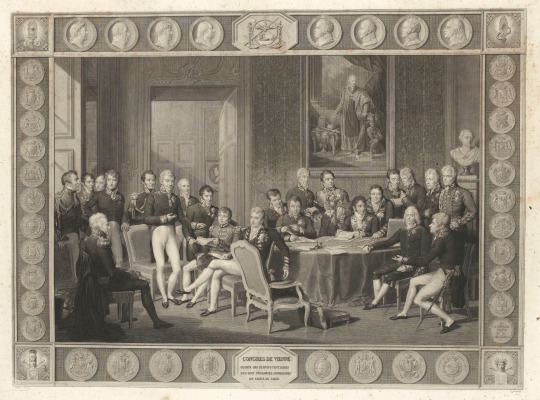
Metternich, the president of the Congress, draws the eye, as the only standing figure in the foreground.
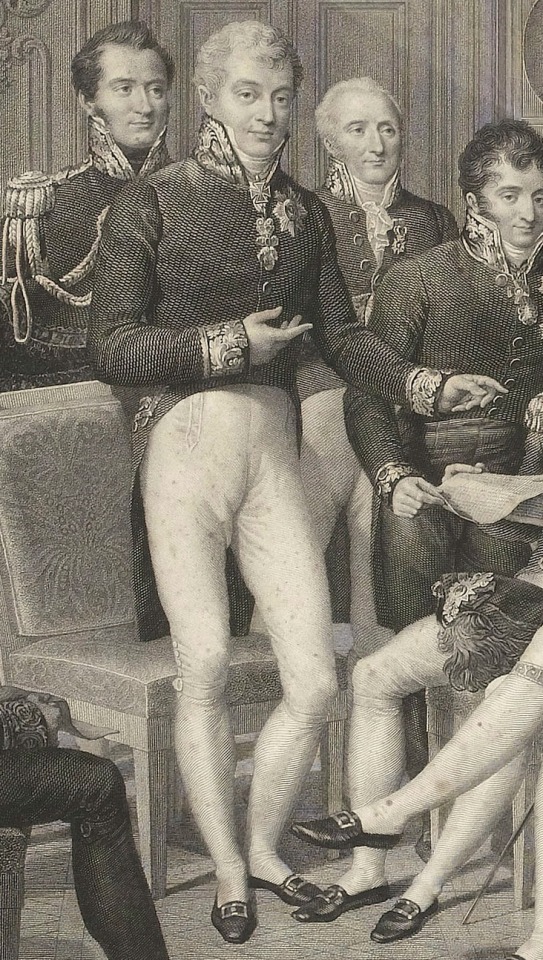
Castlereagh, though, commands the center, sitting with his legs gracefully crossed and elbow resting on the table.
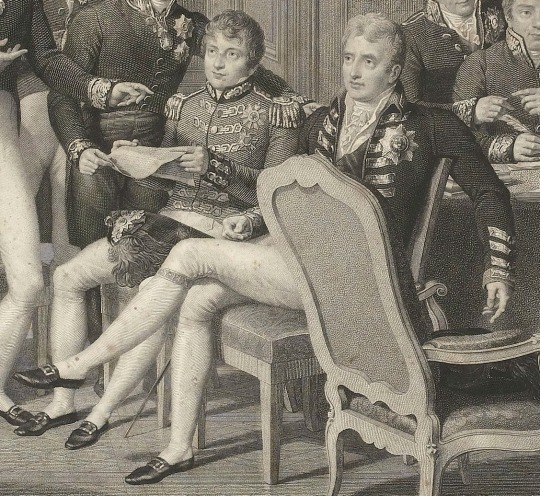
The light shining through the window, however, falls onto Talleyrand, sitting across the table with his dress sword at his side. An empty chair on both his right and left make him further stand out, as do the nearby figures who look to him, just as many of the smaller powers had sought his leadership the last few months.

As Isabey was putting the finishing touches to his composition, he had to figure out what to do about the fact that the Duke of Wellington was now also in town. Starting over was out of the question. Omitting a man of his stature was equally impossible. Yet it was not easy to incorporate him into a canvas on which all the best places had already been taken. The painter's solution was simple and elegant: why not make the painting commemorate the Duke of Wellington's arrival in Vienna?
That way, the duke could simply be inserted on the far left side of the painting, without any insult to his position. As for the duke's reluctance to be painted from a side angle (he was self-conscious about his nose), Isabey had overcome that with a well-targeted compliment: didn't Wellington look like the handsome and chivalric Henry IV? Pleased with this comparison, Wellington accepted, joking that Isabey was a "good enough diplomat to take part in the Congress".
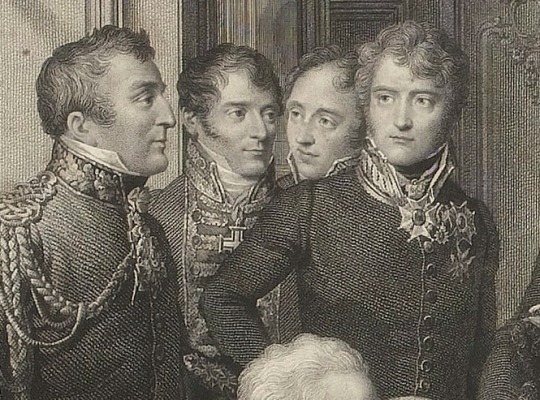
The painter also had to apply his finesse to convince Humboldt to enter the studio. The Prussian ambassador hated to have his portrait made, and, sure enough, he first declined, claiming that he had "too ugly a face ever to spend a penny" on a portrait. With this statement, Isabey saw his opportunity and emphasized that he would not "ask the slightest recompense for the pleasant trouble I am going to take". Isabey only wanted "the favor of a few sittings".
"Oh, is that all?" Humboldt quickly came around when he realized it would not cost him anything. "You can have as many sittings as you like".
Later, many congratulated Isabey on his portrait, particularly the fine job with Humboldt. The Prussian did not pay anything, as agreed, and Isabey got his revenge, Humboldt joked, by painting "an excellent likeness of me".
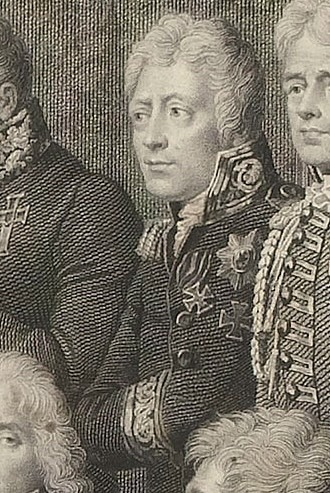
Few could complain of the treatment received from Isabey's flattering brush. This famous painting of the Congress of Vienna was pleasing to all, though typical of this peace conference, the scene was purely imaginary. The group of twenty-three delegates had never met in exactly this way before. Isabey had painted the portraits of each figure individually, and then later assembled the whole group together.
And so, symbolically, this simulated image would commemorate a congress that never was.
After that spectacular depiction of historical context surrounding Isabey’s magnificent canvas by David King few things are left to be added. I would simply love to highlight some other figures of utmost importance for the diplomatic life of that illustrious historical period - there are
Karl August von Hardenberg, Prime Minister of Prussia at the time;
Herren Wacken and Friedrich von Gentz, two Secretaries who were responsible for the protocols of the most important Congress' meetings;
count Karl Vasilyevich Nesselrode, a Russian-German diplomat, who was going to become state chancellor of the Russian Empire (in 1816);
prince Andrey (Andrew) Kirillovich Razumovsky, an extremely wealthy Russian aristocrat and diplomat, for whom Vienna was like his second home;
and we shouldn’t (or rather can’t) forget about general Charles Stewart-Vane, Castlereagh’s younger brother who definitely knew how to throw an unforgettable party, so refined aristocratic society could discuss his wild adventures at their fashionable salon meetings day and night. ✨


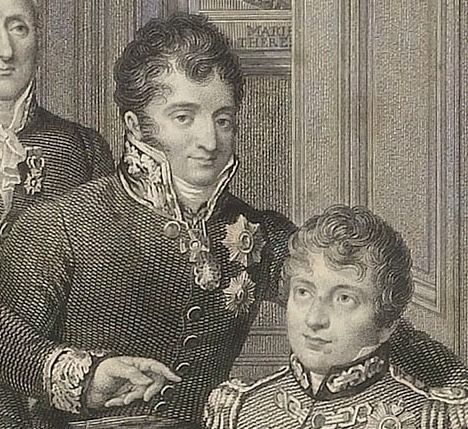
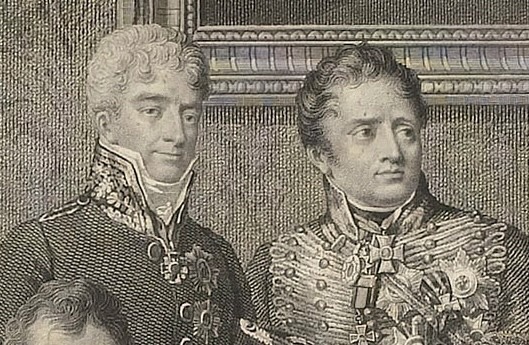
P.S.
Perhaps, there should be more posts with other details of the lithograph as well as Isabey’s original canvas, I’ll just need some time and motivation for that. 👌
#I bet some people know perfectly well what was playing in the background during the arrangement of this post 🤫#the congress of vienna#klemens von metternich#metternich#robert stewart#lord castlereagh#charles-maurice de talleyrand-périgord#talleyrand#wilhelm von humboldt#humboldt#hardenberg#friedrich von gentz#nesselrode#prince razumovsky#charles stewart-vane#napoleonic era#napoleonic wars#19th century#1814#1815
45 notes
·
View notes
Text
Wisdom from the Answer Lady
youtube
I dunno why, I just felt like posting early Sesame Street, mainly because kittens are in it.
#Sesame Street#Kittens#Granny Fanny Nesselrode#Early Sesame Street felt much less polished and much more improvised#I miss that feel#Youtube
0 notes
Note
Hi, I'm curious about what you mentioned on Alexander having a not-so-platonic crush on Hortense. Could you elaborate? (no need to answer right now if you can't!)
Well, mostly that’s me being malicious as usual 😁. But yes, people in Paris at the time did of course wonder what made the tsar – called by some the most handsome man of the era, according to Hortense’s biographer Marie-Hélène Baylac - go to Malmaison of all places during his time in Paris 1814. And they surely did not assume it had anything to do with 50-year-old Josephine, but with her daughter Hortense. Who may not have been as beautiful, but had the reputation of being very distinguished and rather … friendly, especially with men.
Hortense and the tsar met for the first time on 16 April 1814, according to a footnote by Jean Hanoteau in volume 2 of Hortense’s memoirs. Hortense makes a big point about how she at first behaved in a very dignified, almost cold manner to this enemy of France and how it took both Josephine’s persuasion and the efforts of several diplomats, Caulaincourt and Nesselrode among them, for her to befriend him. This is to some degree confirmed by the memoirs of her reader Louise Cochelet. However, that degree may not be very high, considering that Louise Cochelet’s memoirs were published and edited (rewritten?) by Hortense herself. Memoirs of contemporaries indicate that it was rather Louise Cochelet who ran after the new Russian masters of Paris and tried to win them over to the Beauharnais cause. Even if Hortense claims it in her memoirs, it seems doubtful that Louise (Hortense’s closest confidante, keeper of all her secrets down to the existence of a certain Duc de Morny) would have acted on her own accord.
In the end, it does not matter. A close friendship developped, that much is sure. As Hortense states in her memoirs:
What's most appealing about him is that his need for affection seems to be part of his character. He inspires confidence because he knows how to show it. [...] I liked his character. I felt friendship for him and it is painful to expect any service from those whom we would like to love for themselves. So I left my initial reserve and allowed myself a greater degree of abandonment [...].
Both had an interest in the spiritual, both were rather romantic and enthusiastic. According to Hortense’s memoirs, Alexander even pondered inviting both Hortense and her mother to Saint Petersburg. The tsar went out of his way for Hortense (as he later would for Eugène, when the latter reached Paris). It was probably he who bullied Louis XVIII into making Hortense a "Duchess of Saint-Leu", and into allowing her to keep her sons with her in France, when technically, she was of course a Bonaparte and should have been affected by the law that exiled all members of the family, just like her husband. Hortense’s sons were, after the little ex-King of Rome, the next pretenders to the imperial throne. So Louis XVIII had to agree to have his own rivals grow up right before his eyes, that’s surely asking a lot from a monarch.
When Josephine died, Hortense was so overcome with grief – she writes – that she did not see anyone. Except for one visitor: Tsar Alexander.
Finally, when Alexander left for London, his depart started a very personal and, from Hortense’s side, sometimes gushy correspondence between them. They also must have met during Hortense’s stay in Baden. Interestingly, both Hortense and Alexander at that time have troubles with their longterm lovers: Handsome Flahaut, the father of the Duc de Morny, does propose to Hortense after Napoleon’s fall, suggesting Hortense should officially divorce. Hortense however refuses, and her relationship to Flahaut takes a severe blow (he will soon find a bride elsewhere). Alexander, as to him, during the same year ditches his mistress Maria Antonovna Naryshkin. And he confides about this to – Hortense.
Baylac cites one of Hortense’s letters as follows:
[…] when I think of the sovereign who has shown an interest in me, who has looked after my affairs with kindness, I am grateful, I wish for his happiness, and that is all; but when I think of the man who showed me friendship and confidence, when I remember that he tried to love me, my troubles advise me to hope in providence; finally, he knew how to speak to my heart, for how many times since, feeling emotion or fear about the future, I have resigned myself by saying: My God, I trust in you! Ah, the one whose feelings are so similar to mine, he is a friend, a support that heaven has sent me.
It’s maybe not completely astonishing that the tone of this correspondence has made, as Baylac puts it, "certain biographers doubt the platonic nature of their relations".
This relationship, whatever its nature, continued until the Hundred Days. At this point, Eugène was in Vienna, taking part in the Vienna Congress. The secret police (allegedly?) intercepted (falsified? - it’s so hard to find the truth about what happened within all these intrigues!) several letters, at least one from Hortense, badly hidden in a brush she had sent to her brother. I have read that Hortense in one letter openly mocked the tsar. The intercepted letters were shown to Alexander, who then passed them on to Eugène – ostentatiously opened – before breaking off all relations with both Beauharnais siblings.
Interestingly, his friendship with Eugène was soon healed. With Hortense? Not so much. To my knowledge, never. Alexander obviously felt truly hurt by her, in a similar way as he felt hurt by Caulaincourt’s behaviour. Admittedly, I have not looked into Hortense’s years in Bavaria much, but it seems when the tsar and tsarina visited Bavaria, and the tsar insisted on Eugène being of the party (much to the chagrin of queen Karoline 😊), Hortense was very much not invited. (Though, truth be told, it seems she was only rarely invited to Munich ever.)
So, that’s the base for my maliciousness 😁. Make of it what you want. As i do not have much faith in Hortense’s professed virtue in general, I am probably not the best judge of character in her case.
Thank you for the Ask! 💝💝💝
27 notes
·
View notes
Text

Menu Monday: A stained example from February 11, 1888, for Princeton at Delminco's restaurant in New York.
One fun fact about this menu: It included frozen nesselrode pudding, a once-popular dessert made from cream, chestnuts, dried fruits, candied fruits, and maraschino liqueur. These days, you may see this forgotten dish making a comeback in a restaurant near you.
Scrapbook Collection (AC026), Box 126
The entire Menu Monday series
9 notes
·
View notes
Note
Miss Dearest you remind me of "Granny Granny Nesselrode"
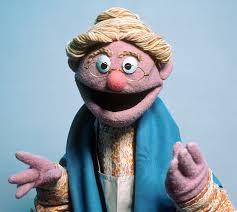
(your talking about her right)
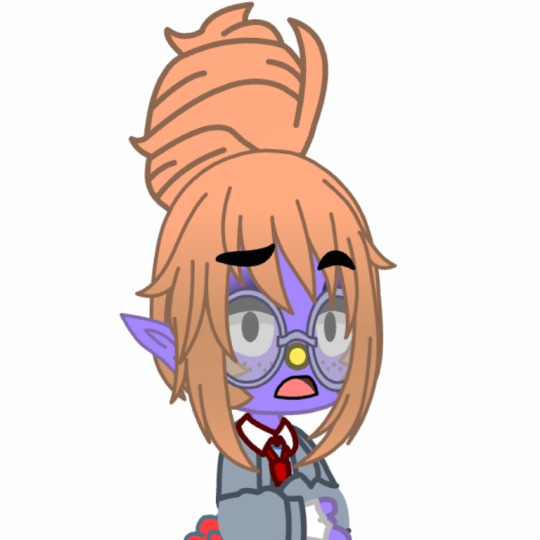
Abby: I'm confused on why your comparing me to her I don't look like her..

Abby: Violet do I look like her-
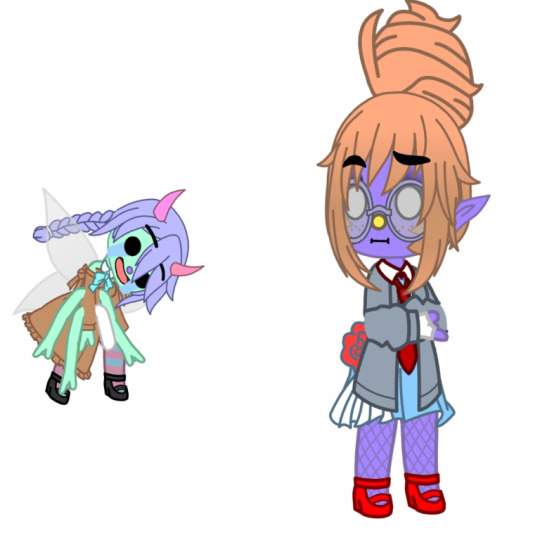
*Violet dying in laughter*
7 notes
·
View notes
Text
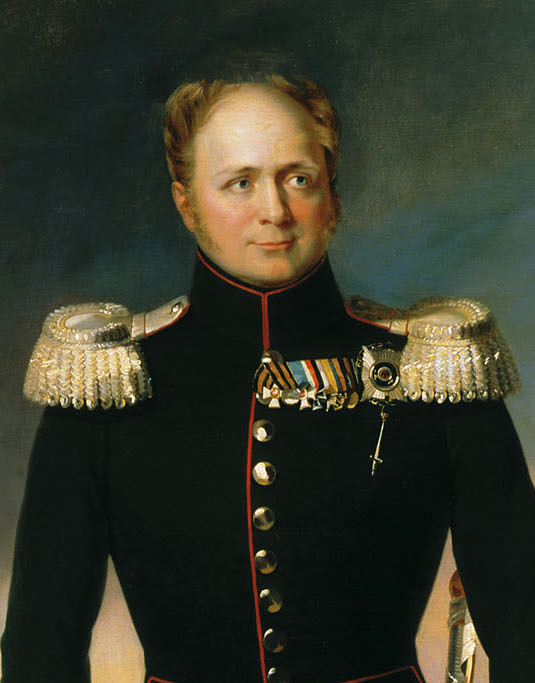
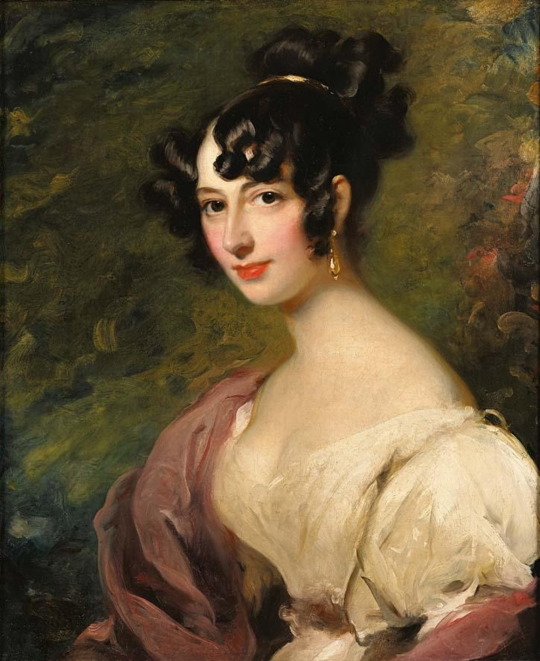
Dear Alexander,
Two letters from you received at the same time have made me quite happy. One of them, it is true, was not very recent, as it bore the date of the month of July— the other that of October — and the day before yesterday one from Valiki Lonki dated November. Thanks for having at last bethought yourself of me. You shall now see how diligent in writing I am going to be, now that at least I am assured that it is in Russia that my letters will have to seek you, for I assure you that for six months I was in ignorance of your whereabouts, firmly believing that you were on the march with some army corps in Germany. Did Prince Pierre Wolkonsky ever forward to you a letter which I sent under cover to him at Warsaw ?
I have been moving about a good deal of late. I have been twice to Brighton by command ' of the Prince Regent, the first time to stay there during the Queen's visit, and on the second occasion to amuse the Archdukes, who, by the way, are not very amusable. After that I went to spend a few days with Lady Jersey, Lady Cowper, and others, and to-morrow I am off to the Marchioness of Salisbury's, and elsewhere — and finally I shall settle down in London , where for the last six weeks I have not passed three consecutive days.
My life in England is now very different from what you knew it. For this it only needed to give way to a little dissipation, and now I am literally fought for. It is not fashionable where I am not, and I have even arrived at amusing the English and amusing myself at the same time. This may last as long as it will, but I declare that I have no desire to die here. General Flahaut is in England— you have doubtless heard speak of him, and perhaps met him when in Paris. He is half proscribed, but as Talleyrand, who is his real father protects him, he has been allowed to escape from France and has taken refuge here. General Flahaut is in England— you have doubtless heard speak of him, and perhaps met him when in Paris. He is half proscribed, but as Talleyrand, who is his real father^ protects him, he has been allowed to escape from France and has taken refuge here. No one talks of anybody except him, and he is declared delightful. We have a very agreeable man,. Prince Paul Esterhazy, as our Austrian colleague. His wife is coming shortly ; she is grand-niece of the Queen of England. I don't know how we shall get on together. Balmaine is gone back to Paris, while awaiting the fitting out of the ship which is to convey him to St. Helena. It was Nesselrode's department which caused the post to be offered to him ; for my own part, I should never have thought of recommending him for it.
2 notes
·
View notes
Text
A NIGHTMARE ON ELM STREET 3: DREAM WARRIORS (1987) – Episode 224 – Decades Of Horror 1980s
“Welcome to prime time, bitch!” Not words I’d use in front of my mother, but they are iconic just the same. Join your faithful Grue-Crew – Chad Hunt, Bill Mulligan, Crystal Cleveland, and Jeff Mohr, along with guest host Ralph Miller – as they enter another Wes Craven nightmare, A Nightmare on Elm Street 3: Dream Warriors (1987). Expect a lot of FX talk with Ralph in the house!
Decades of Horror 1980s
Episode 224 – A Nightmare on Elm Street 3: Dream Warriors (1987)
Join the Crew on the Gruesome Magazine YouTube channel!
Subscribe today! And click the alert to get notified of new content!
https://youtube.com/gruesomemagazine
A psychiatrist familiar with knife-wielding dream demon Freddy Krueger helps teens at a mental hospital battle the killer who is invading their dreams.
[NOTE: Effects crew credits are listed as they appear in the film credits.]
Director: Chuck Russell
Writers: Wes Craven (story) (screenplay) (characters); Bruce Wagner (story) (screenplay); Frank Darabont (screenplay); Chuck Russell (screenplay)
Music: Angelo Badalamenti
Storyboard Artist / Visual Consultant: Peter von Sholly
Stop-Motion Skeleton and Marionette Effects: Doug Beswick Productions, Inc.
Stop-Motion Animation: Doug Beswick
Effects Photography Supervisor: Jim Aupperle
Stop-Motion Puppet Construction: Yancy Calzada
Marionette Construction: Mark Bryan Wilson (as Mark Wilson)
Miniatures: James Belohovek
Illustrator: Larry Nikolai
Makeup effects Sequences: Greg Cannom
Assistants to Greg Cannom: Larry Odien, Earl Ellis, John Vulich, Keith Edmier, Brent Baker
Krueger Makeup effects: Kevin Yagher
Assistants to Kevin Yagher: Jim Kagel, Mitch DeVane, Gino Crognale, Brian Penikas, David Kindlon, Steve James, Everett Burrell
Makeup Effects Sequences: Mark Shostrom
Assistants to Mr. Shostrum: Robert Kurtzman, Bryant Tausek, John Blake Dutro, James McLoughlin (as Jim McLoughlin), Cathy Carpenter
Additional Makeup Effects: Matthew W. Mungle (as Mathew Mungel)
Assistant to Mathew Mungel: Russell Seifert
Mechanical Effects: Image Engineering
Special Effects Coordinator: Peter Chesney
Lead Technician: Lenny Dalrymple
Mechanical Designers: Bruce D. Hayes (as Bruce Hayes), Joe Starr, Anton Tremblay (as Tony Tremblay)
Effects Technicians: Bernardo F. Munoz (as Bernard Munoz), Rod Schumacher, Bob Ahmanson
Effects Crew: Scott Nesselrode, Tom Chesney, Kelly Mann, Phillip Hartmann (as Phillip Hartman), Ralph Miller III (as Ralph Miller), Joel Fletcher, Brian Mcfadden, Sandra Stewart (as Sandy Stewart), Terry Mack (as Troy Mack), Blaine Converse, Ron MacInnes, Brendan C. Quigley
Selected Cast:
Heather Langenkamp as Nancy Thompson
Craig Wasson as Dr. Neil Gordon
Patricia Arquette as Kristen Parker
Ken Sagoes as Roland Kincaid
Ira Heiden as Will Stanton
Rodney Eastman as Joey Crusel
Jennifer Rubin as Taryn White
Penelope Sudrow as Jennifer Caulfield
Bradley Gregg as Phillip Anderson
Laurence Fishburne as Max Daniels (credited as Larry Fishburne)
John Saxon as Donald Thompson
Priscilla Pointer as Dr. Elizabeth Simms
Clayton Landey as Lorenzo
Brooke Bundy as Elaine Parker
Nan Martin as Sister Mary Helena
Stacey Alden as Nurse Marcie
Dick Cavett as Himself
Zsa Zsa Gabor as Herself
Paul Kent as Dr. Carver
Guest host Ralph Miller III, who worked behind the scenes on Dream Warriors provides insights and many effects development photos that are shown in the YouTube version of the podcast. Post-recording, the crew wants to clarify that Kevin Yagher was responsible for the Freddy Snake, and Mark Shostrom was in charge of the Penelope Sudrow dummy that smashes into the Freddyvision TV.
With the success of A Nightmare on Elm Street 3: Dream Warriors (1987), following the critical failure of A Nightmare on Elm Street 2: Freddy’s Revenge (1985), New line Cinema firmly cemented Freddy Krueger and A Nightmare on Elm Street as one of the most iconic horror franchises of its time. Not only does Dream Warriors feature Robert Englund continuing to breathe both humor and fear into Freddy Krueger but also the return of both Heather Langenkamp and John Saxon from the original. The film also features Craig Wasson (Ghost Story) as the male lead and early film roles for Patricia Arquette and Larry Fishburne. Frank Darabont (The Mist) and Bruce Wagner join Wes Craven on scripting chores and Chuck Russell (The Blob, The Mask) directs while Angelo Badalamenti (Twin Peaks, Blue Velvet) provides the score – a winning combination of talent. Surely a Grue-Crew highly recommended selection with special effects by Greg Cannom, Doug Beswick, Mark Shostrom, Kevin Yagher, and more!
Be sure to check out the first time the 80s Grue-Crew took a dive into this film in February 2017, featuring Doc Rotten, Christopher G. Moore, and Thomas Mariani as the Grue-Crew. You can find it here: A NIGHTMARE ON ELMS STREET 3: DREAM WARRIORS (1987) — Episode 102
Every two weeks, Gruesome Magazine’s Decades of Horror 1980s podcast will cover another horror film from the 1980s. The next episode’s film, chosen by Jeff, will be The Changeling (1980), starring George C. Scott, Trish Van Devere, Melvyn Douglas, . . . and a bouncing, red, rubber ball.
Please let them know how they’re doing! They want to hear from you – the coolest, grooviest fans – so leave them a message or comment on the gruesome Magazine Youtube channel, on the website, or email the Decades of Horror 1980s podcast hosts at [email protected].
Check out this episode!
5 notes
·
View notes
Text
18 Delicious Picnic Food That Starts With N
0 notes
Text
James Whitfield Thomson
Author James Whitfield Thomson is a former sales executive who spent time in the U.S. Navy during the Vietnam War. He is the first member of Andre Dubus's writer's workshop, and his debut novel, LIES YOU WANT TO HEAR, is an intense and moving read. He is an experienced writer, having written several novels and short stories and published them in literary journals. He lives in Natick, Massachusetts, with his family.
After graduating from Harvard College on a scholarship, he went on to earn his Ph.D. in American Studies at the University of Pennsylvania. He has served in the U.S. Navy as a navigator. He lives in Natick with his wife, and has published five novels, including Agni. His first novel, The Long Winter, was published in 2011. His work has won several awards and was nominated for a Pushcart Prize and the National Book Critics Circle Award.
The author was part of Andre Dubus's writer's workshop, and he's now a well-known figure in the world of literature. A native of Pittsburgh, he attended Harvard College and obtained his Ph.D. in American Studies at the University of Pennsylvania. He also served in the U.S. Navy, and is an author of the novel Agni. The book has been a bestseller, and Thomson has received a grant from the Massachusetts Council of the Arts.
The author's novel Archimedes Nesselrode is based on an article that first appeared in a Boston newspaper. He and his wife, Elizabeth, live in a Victorian farmhouse outside of Boston. The couple have five children and a dog, and they are currently raising a son. The book will appeal to true crime fans. It's also great for children. A biography of the author will be available soon.
A member of Andre Dubus's writer's workshop, James Whitfield Thomson was born and raised in Pittsburgh, and went on to earn his Ph.D. in American Studies at the University of Pennsylvania. He has served in the U.S. Navy in Vietnam and has written several books. His novel Agni is based on an actual newspaper article, and has won the Massachusetts Council of Arts grant. While the book's author is well known for his works, his writing is not yet well known.
The novel's title refers to an article in a Boston newspaper that detailed a man's actions in a kidnapping case that occurred 20 years ago. The novel features the mother's life as she tries to get a job at the library where her daughter was abducted. The family lives in a Victorian house outside of Boston. Jim and his wife, Elizabeth, have five children. While they don't live in Boston, they still live in their beloved home.
This book is based on a true story of a father and his three daughters. The man kidnapped his daughters twenty years ago and the family now lives in a Victorian farmhouse outside of Boston. The authors also have five children. The author is a member of Andre Dubus's writer's workshop. This is the fifth book in the series. A few readers may be surprised at the number of stories and poems about children.
This novel is based on a true story. A man abducted his two daughters in Boston twenty years ago. The author uses the true story to create a fictional story. The main character is Jonathan Edwards. There is a family of eleven children. They live in a farmhouse outside of Boston. Andre Dubus and his wife live in the house. This novel is a memoir of their lives. The author's mother, Leah, is an herbalist who bears 11 children.
This novel is a true story about a father who kidnapped his daughters twenty years ago. The story is a true story of the man who abducted his daughters and their mother. The author gives a detailed account of the events of their lives. The author has a strong sense of justice and the ability to tell the truth. He has made writing his passion for more than ten years. There is no better way to get the story out than by writing it.
jameswhitfieldthomson.com -life hero, Andre Dubus was a member of the writer's workshop at Harvard University. The two of them were also part of Andre Dubus's writing workshop. The stories of Andre and Jim are inspired by a true story from twenty years ago. The author has also a great knowledge of history. This is a memoir about a man's life. In it, the author describes the lives of his children in the present.
1 note
·
View note
Photo

Povijest Crnogorska 2.
U tim uslovima, uz nepovoljan stav konzula, putovanje Petra II nije moglo proći glatko. Njegoševa posjeta Sankt Peterburgu mogla je izazvati nepoželjne glasine u Istanbulu i Beču, te je stoga Nesselrode odmah naredio ruskoj ambasadi u Beču da ubijedi Njegoša da se vrati, koja je, slijedeći ove upute, privela gospodara u austrijsku prijestolnicu. Pošto nije dobio pozitivan odgovor od ruskih vlasti, Petar II se obratio francuskoj ambasadi sa zahtjevom da mu izda pasoš za putovanje u Pariz. Nakon toga, A.M. Gorčakov, koji je bio zadužen za poslove ruske ambasade u odsustvu D.P. Tatiščov, pozvao Njegoša da ode u Rusiju. U ovoj odluci ruskog diplomatskog predstavnika podržao je i austrijski kancelar K. Metternich, koji se s pravom bojao. Boravak Petra II Negoša u Beču stvarao je probleme ruskim i austrijskim vlastima i zbog toga što je vladika pokušao da skrene pažnju evropske zajednice na crnogorske probleme. U glavnom gradu Austrije, Negosh se često sastajao sa V.S. Karadžića, uz čije je posredovanje upoznao agenta srpskog kneza Miloša, izvesnog V. Hopea, dopisnika minhenskog lista Allgemeine Zeitung. Iza Vladyke uspostavljen je prećutni nadzor i od strane austrijskih vlasti i ruske vlade. Kapetan F. Orešković je austrijskoj vladi izvještavao detaljne izvještaje o svojim razgovorima sa Njegošem. Ruska vlada je ove dužnosti povjerila potpukovniku Ozeretskovskom. Sredinom februara 1837. Ozeretskovski je napisao poseban izvještaj grofu Benkendorfu, u kojem je detaljno objasnio razloge koji su Petra II naveli da ode u Sankt Peterburg, ističući njihovo nerazumijevanje od strane ruskih zvaničnih krugova, što je primoralo crnogorskog vladara da traži prilika za putovanje u Pariz . Dok pitanje posjete Petrogradu još nije bilo riješeno, Ozeretskovski je crnogorskom gospodaru i njegovom rođaku Georgiju Petroviču, koji su ga pratili na putovanju, dao pismo preporuke, što je izazvalo gnjev vlasti. Ruski agent je svoj čin opravdao rekavši da ne želi da „još više nervira [ovu] gospodu“.
Za razliku od 1833. godine, Njegoš je očekivao izuzetno oprezan prijem u Rusiji. U tome su značajnu ulogu odigrali Vladikini zlobnici, posebno I. Vukotić, koji je širio glasine o njegovoj lošoj vladavini, pronevjeri manastirskih sredstava itd. Neselrode je o tome pisao Njegošu: „Ovde smo dobijali izveštaje da su vaša naređenja izazvala pometnju među narodima i krvoproliće, da su mnoge crnogorske porodice pobegle u turske krajeve i na razne strane, da je narod veoma ogorčen na vas, da je vaše mešanje protiv volja ljudi u Grahovu bila je povod za paljenje njegovih sela i pobistvo mnogih stanovnika, koji su pre toga, odajući mali danak Turcima, bili u miru, i da se, konačno, crnogorski narod ogorčio no Vi, da ste otišli pod izgovorom najviše komande da dođete u Sankt Peterburg. Petar II Negoš je bio zatočen u Pskovu, dok se nije razjasnilo pravo stanje u Crnoj Gori, a carska tajna policija nad njim uspostavila nadzor. Sam Vladika je pokušao da opovrgne optužbe na njegov račun. Napisao je Nesselrodeu: „Ali u međuvremenu, tuga u mojoj duši je otprilike ista stvar: da sam nevino optužen pred licem monarha, uzimam slobodu da odam vašu ekselenciju u poštovanje za sljedeće: Imam nijedan jezik kojim bih mogao adekvatno da iskažem patnju svog srca, da je ova apsurdna, pretjerana kleveta tako gorko ocrnila moje ozbiljne namjere za dobrobit crnogorskog naroda, pred uvijek velikodušnim monarhom, kojeg on i ja obožavamo i uvijek velikodušni. Govorio je i o svojim civilizacijskim nastojanjima: „Prije mog ulaska u titulu vladara i gospodara Crne Gore, Crna Gora je bila jadna sramota građanskih sukoba i svih vrsta nesuglasica; jaki su opljačkali nemoćne, pleme se borilo protiv plemena, a mira nije bilo i nikad nije bilo, pravo jakih je trijumfovalo. Uništio sam ovo varvarstvo, uspostavio mir i tišinu, osigurao mir i imovinu svima, što je vrlo dobro poznato, a Vaša Ekselencija to može provjeriti od vašeg vicekonzula u Raguzi i susjedne austrijske vlade”. Istovremeno, Vladika je, smatrajući ne samo sebe uvrijeđenim, već i cijeli crnogorski narod, čak razmišljao da svoju državu prebaci pod zaštitu druge države. Evo šta je o tome napisao kapetan Rakeev, koji je Njegoša gledao u Pskovu: „Arhiepiskop crnogorski Petar Petrovič Negoš se više puta udostojio da odgovori da se zasluge crnogorskog naroda ne cijene i ne nagrađuju. Zemlje koje su im od davnina pripadale ugovorima su ustupljene drugim državama, zbog čega je narod jako ogorčen, kao i zbog samog Grahova, koje je bilo mjesto krvoprolića, <...> i ako dobiju odbijajući u njihovim zahtjevima, iskoristiće priliku da sebe i Crnogorce prebace pod pokroviteljstvo druge države” . Ali, srećom, rusko ministarstvo je ispravno procijenilo situaciju i Njegoš je 18. maja 1837. stigao u Sankt Peterburg, gdje je ostao 24 dana. Vladikina lična objašnjenja sa Nikolom I, kao i činjenica da protiv njega nijesu podignute dovoljno agumentovane optužbe, doprineli su uspešnom završetku putovanja. Godišnja novčana subvencija Crne Gore je povećana. Dodijeljeno je dodatnih 80.000 rubalja uz održavanje 1.000 crvenoneta, koje je odredio Pavle I. Ali vratimo se našem glavnom liku. U martovskoj poruci iz 1837. godine Ozeretskovski je objavio svoje poznanstvo povodom „crnogorskog slučaja“ sa Vukom Stefanovičem Karadžićem. “Ovaj čovjek je veoma učen i lukav. Za srpski rečnik i narodnu pjesmaricu koje je izdao dobija od ruske vlade po hiljadu rubalja u novčanicama penzije. Njegov sin je odgajan kao izdržavan od države u Sankt Peterburgu, u rudarskom korpusu. Ovaj gospodin Karadžić je stalno bio uz Vladiku tokom njegovog boravka u Beču i davao vrlo detaljne i tačne informacije Njegovom Visočanstvo Princu Metternichu o svakom koraku i riječi Njegove Eminencije, sa kojim je dugo bio upoznat i bio prijatelj. Takva privrženost dvjema vladama u isto vrijeme ne sprječava ga da bude čovjek zdravog rasuđivanja i dobronamjernosti” . Međutim, očigledno je da je takvo svjedočenje ozbiljno narušilo Karadžićev ugled u očima rukovodstva III Odjela. Godine 1835. pisac je putovao u Crnu Goru, što je rezultiralo knjigom koja je upravo izašla u Augsburgu. Prvi primjerak "Crna Gora i Crnogorci" Karadžić je poklonio Ozereckovskom na prijenos u rusku ambasadu, a otpravnik poslova A.M. Gorčakov je odmah prosledio knjigu Neselrodeu, pošto su informacije koje su tamo date „izuzetno radoznale i mogu biti korisne za cijli posao koji je Vladika započeo“. Ozeretskovsky je obećao da će vremenom snabdjeti svog šefa i novitetima.
U junu 1837. D. Urquhart, sekretar engleske ambasade, izdavač rusofobičnog časopisa Portfolio, posjetio je Beč na putu od Carigrada do Londona. Ozeretskovski ga, iz predostrožnosti, nije lično upoznao, već je sa strane, u kafani, posmatrao: „Ima dve sluge, Turke, u narodnoj nošnji. Zbog toga se radoznali zaustavljaju.” Ali V.S. se sastao s Urquhartom. Karadžić, koji je najavio namjeru Engleza da se za pet mjeseci vrati u Beč kako bi organizovao putovanje u Bosnu, Hercegovinu i Crnu Goru. „Poziva Vuka sa sobom na ovaj put, pod uslovom da mu bude vodič i tumač među hrišćanima, a što se tiče Turaka, kaže Urquhart, nemaš šta da brineš, osloni se na mene, ovo su moji prijatelji. Vuk rado prihvata ovaj predlog, rekavši da na ovaj način može prikupiti mnogo literature i istorijskih slovenskih podataka. Karadžićev promiskuitet ponovo je svjedočio protiv njega. Ali upravo su njegove informacije poslužile kao dodatni dokaz sve veće aktivnosti Britanaca u regionu Balkana.
Osim toga, Urquhart je ponudio da prevede na njemački knjigu punu optužbi protiv ruskih agenata u Beogradu 1807-1813. K.K. Rodofinikin i F.I. Nedoby . Karadžić je oprezno odbio ovo dijelo, ali je uspeo da na kopiji Urkvarta primeti ime najstarijeg sina srpskog kneza. „Zato treba misliti“, zaključio je Ozeretskovski, „da je knjigu dobio na poklon prolazeći kroz Srbiju, gde je boravio kod kneza Miloša [Obrenovića]. Kako Urquhart ne traži materijal. Izražavajući zabrinutost zbog antiruske kampanje u novinama, Ozeretskovsky je pokazao vjernost zvaničnim dogmama: „Povici protiv moćnog cara Rusije su slabi! Veliki je ruski Bog. Ali, saznavši za rezultate putovanja crnogorskog gospodara u Sankt Peterburg, ponovo se prisjetio Urquharta i plašio se publiciteta, jer će se to „odgovoriti kasnije u velikom pitanju Slovena...“ . Pa, potpukovnik žandarmerije ubrzo je imao priliku da pokaže svoje sposobnosti stručnjaka za ovu stvar.
Karadžić je i dalje ostao važan doušnik žandarmerijskog potpukovnika: „... meni se često dešava i nada se da će dokazati svoju lojalnost ruskoj vladi tako što će mi dati sve tajne podatke o Slovenima, austrijskim podanicima, Srbima.
0 notes
Photo
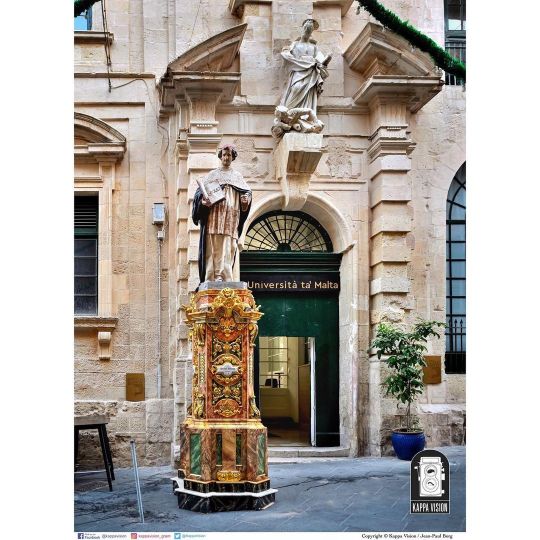
The entrance of the Old University Building in Valletta with a statue of St. Ignatius of Loyola and a defaced coats of arms. The building adjacent to the Jesuit church in Merchants Street originally had a rather plain façade, with practically no decoration whatsoever. A Baroque facade was re-designed in 1647 by famous architect Francesco Buonamici. THE STATUE OF ST. IGNATIUS This statue was erected on the main entrance of the college at the expense of the German Grand Prior of the Order of St. John, Count Fra Philipp Wilhelm Nesselrode-Reichenstein (1677-1754), motivated primarily by his devotion towards the saint. It was one of the first five stone statues in Valletta. Originally it had a small oil lamp. The Jesuit saint is holding a book (Jesuit Rule) while crushing Satan under his foot. MEPA scheduled the statue of St. Ignatius with Grade 1 protection as per Government Notice No. 0276 dated 2008. THE COLLEGIUM MELITENSE - A BRIEF OVERVIEW The Collegium Melitense in Merchants Street was a Jesuit college in Valletta. It was active between 1592 and 1769. Lectures at the educational institution began in 1593, and it later moved to a purpose-built building adjacent to a Jesuit church in 1597. The 17th century saw an expansion of its curriculum and an increase in the number of students in the college. By 1727 it was recognised as a university and subsequently it also became known as the Academia Parthenia. After the Jesuits were suppressed from Malta, the college was reorganised into the Pubblica Università di Studi Generali, which was established on the 22nd of November 1769. The latter is now known as the University of Malta. (at Valletta, Malta) https://www.instagram.com/p/ChWbfj_o2WZ/?igshid=NGJjMDIxMWI=
0 notes
Quote
Nesselrode's highest-level informant in Paris was Charles Maurice de Talleyrand-Perigord, the most sophisticated diplomat of his era as well as an expert in transferring allegiance from one regime to another. Born an aristocrat under the Ancien Regime, he had become an atheist and begun a career as a bishop before becoming, successively, a prominent revolutionary, Napoleon's Foreign Minister, restorer of the Bourbon dynasty after his defeat, and, finally, French ambassador in London. Napoleon knew that Talleyrand was untrustworthy and dismissed him as Foreign Minister in 1807, after complaints from the kings of Bavaria and Württemberg about the large bribes he was demanding from them. Napoleon, in a fit of rage, accused Talleyrand of betraying everyone, called him 'a turd in a silk stocking', threatened to hang him from the iron railings outside the Tuileries Palace, then stormed out. Talleyrand said regretfully after his departure: 'What a pity, such a great man and so ill-mannered!'
Christopher Andrew, The Secret World
#quote#quotation#Christopher Andrew#Nesselrode#informant#Talleyrand#diplomat#traitor#Napoleon#insult#manners#bribes
6 notes
·
View notes
Photo
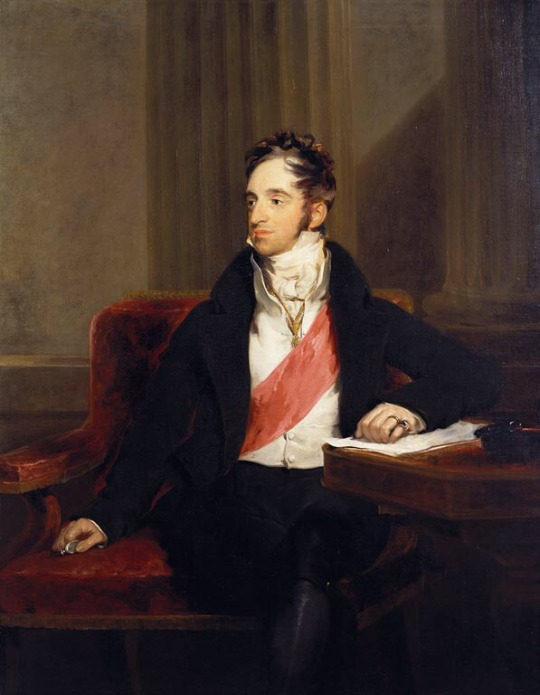
Windsor Castle, Waterloo Chamber.
2 notes
·
View notes
Photo

Finally finished the sweater for @hobbitoftheshire (my very first sweater!) Front pattern is berroco's nesselrode, yarn is berocco vintage chunky in pumpkin. It looks good on both of us so major win.
2 notes
·
View notes
